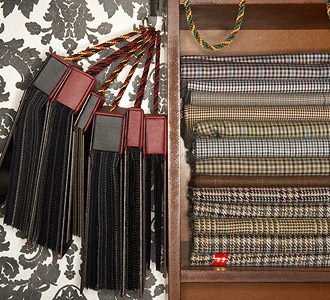to the finished garment.
No amount of tailoring skill is able to disguise the use of inferior materials. The production of luxury cloth, from the initial shearing of the sheep to the supplying of it to the tailors of Savile Row, is a meticulous, time-honoured process.
First the sheep is sheared of its wool, which tends to happen once a year. The wool then goes through a process called ‘top making’, where the raw fibres are prepared using five separate stages, namely blending, scouring, rinsing, carding and finally combing.
Once a ‘wool top’ has been created, the wool is then dyed to give the desired colour. Alternatively, wool can be yarn dyed or piece dyed. Wool holds dye very well, which is highlighted when looking at the wonderful archives held by the associate members of our organisation.
The dyed wool is then spun into yarns, which go to the woollen mill for weaving. Once woven, each cloth is then inspected before it goes to the finishers to set before it can be used in tailoring. Other superb cloths such as pure or blended cashmere, mohair and angora are used, but pure British wool remains the Savile Row tailors’ staple.
Britain has a long, illustrious history of making fine pure woollen cloths for tailoring. Members of the Savile Row Bespoke Association are proud to support the Campaign for Wool, as well as the British woollen mills that continue to produce world-class woollen cloths.



